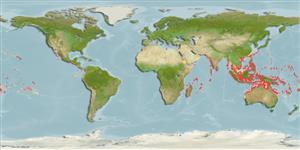Common names from other countries
>
Anguilliformes (Eels and morays) >
Muraenidae (Moray eels) > Muraeninae
Etymology: Gymnothorax: Greek, gymnos = naked + Greek, thorax, -akos = breast (Ref. 45335); fimbriatus: Named for Tamara Mikhailovna Ambrozhevich (Ref. 57775).
More on author: Bennett.
Environment: milieu / climate zone / depth range / distribution range
Ecologia
marinhas; estuarina associadas(os) a recifes; intervalo de profundidade 0 - 50 m (Ref. 90102). Tropical; 30°N - 28°S
Indo-Pacific: Madagascar (Ref. 33390) to the Society Islands, north to southern Japan (Ref. 559), south to Queensland, Australia; throughout Micronesia.
Tamanho / Peso / Idade
Maturity: Lm ? range ? - ? cm
Max length : 93.4 cm TL macho/indeterminado; (Ref. 121652); 87.2 cm TL (female); peso máx. publicado: 1.5 kg (Ref. 121652); peso máx. publicado: 1.5 kg
Vértebras: 128 - 142. Adults pale with small black spots on face; black spots proportionally much larger in young (Ref. 30404).
Occurs in lagoons, reef flats and seaward reefs (Ref. 1602, 48635). Prefers protected inshore waters among dead corals, common in harbors and small caves (Ref. 30404). Probably nocturnal (Ref. 1602). Feeds on fishes and crustaceans (Ref. 9710). Possibly a protogynous hermaphrodite (Ref. 32169). Current age of a captive individual is 18 years, which exceeds 100 cm and approximately 10 lbs (owner Mark Palermo, pers. comm. 07/12). Minimum depth reported taken from Ref. 86942.
Ciclo de vida ou comportamento de acasalamento
Maturities | Reprodução | Spawnings | Egg(s) | Fecundities | Larvas
Protogyny unconfirmed (Ref. 84746).
Chen, H.-M., K.-T. Shao and C.T. Chen, 1994. A review of the muraenid eels (Family Muraenidae) from Taiwan with descriptions of twelve new records. Zool. Stud. 33(1):44-64. (Ref. 6934)
Status na Lista Vermelha da UICN (Ref. 130435)
CITES (Ref. 128078)
Not Evaluated
Ameaça para os humanos
Harmless
Uso pelos humanos
Pescarias: pouco comercial
Ferramentas
Relatórios especiais
Baixar XML
Fontes da internet
Estimates based on models
Preferred temperature (Ref.
115969): 24.9 - 29, mean 28 (based on 774 cells).
Índice de diversidade filogenética (Ref.
82804): PD
50 = 0.5000 [Uniqueness, from 0.5 = low to 2.0 = high].
Bayesian length-weight: a=0.00040 (0.00027 - 0.00059), b=3.31 (3.20 - 3.42), in cm Total Length, based on LWR estimates for this species & Genus-body shape (Ref.
93245).
Nível Trófico (Ref.
69278): 4.0 ±0.67 se; based on food items.
Resiliência (Ref.
120179): Baixo, tempo mínimo de duplicação da população 4,5 - 14 anos (Preliminary K or Fecundity.).
Fishing Vulnerability (Ref.
59153): High vulnerability (57 of 100).
